Effect of Molecular Composition of Head Group and Temperature on Micellar Properties of Ionic Surfactants with C12 Alkyl Chain
Abstract
:1. Introduction
2. Experimental Parts
2.1. Material and Equipment
2.2. Method
3. Results and Discussion
3.1. Determination of Critical Micelle Concentration (CMC)
- The increased temperature may decrease hydration of hydrophobic groups of surfactants, which in turn supports the formation of micelles.
- The temperature accelerates breaking of the water structure around the hydrophobic group, which in turn suppresses the formation of micelles.
3.2. Determination of Degree of Counterion Binding (β)
3.3. Determination of Thermodynamic Parameters of Micellization
4. Conclusions
- Values of CMC depend on composition of the hydrophilic part of surfactants. The higher molar mass of hydrophilic group significantly influences the process of micellization.
- Depending on the packing parameter, the surfactants with a single-long hydrocarbon chain create spherical micelles while those having double-long chains create vesicles.
- Values of CMC depend linearly on molar weights of the hydrophilic group.
- In general, a good agreement exists between values of CMC obtained here and those obtained by other researches and/or different physicochemical methods. This indicates that the conductometry seems to be a very suitable method especially for ionic surfactants.
- Calculated values of the counterion binding anions (β) decrease linearly with increasing system temperature.
- Thermodynamic values of micellization
- For calculation of thermodynamic values of micellization the pseudo phase model was used.
- Values of ΔmG0 change non-linearly with increasing temperature. All curves reach shallow minima at the temperature 303.15 K or 308.15 K. Changes of ΔmG0 are, within the analysed interval, very small. All calculated values of ΔmG0 are negative what indicates a spontaneous micelle formation.
- All values of ΔmH0 are, within the analysed temperature interval, negative, which indicates an exothermic process. It means that a major attractive force of micellization of surfactants comes from the hydrophobic interaction.
- Values of ΔmS0 are positive at low temperatures but at higher temperatures they change from positive to negative.
- By analysing of the experiments one can observe that at the temperatures below 298.15 K a more significant contribution to ΔmG0 is caused by ΔmH0 and above this temperature it is ΔmS0.
Author Contributions
Funding
Conflicts of Interest
References
- Friberg, S.E. Food Emulsion; Marcel Dekker Inc.: New York, NY, USA, 1976. [Google Scholar]
- Schramm, L.L.; Stasiuk, E.-N.; Marangoni, D.-G. Surfactants and their Applications. Annu. Rep. Prog. 2003. [Google Scholar] [CrossRef]
- Kabir-UD, B.; Malik, A.-R.; Andleeb, Z.-N. Micellization of Mixtures of Amphiphilic Drugs and Cationic Surfactants: A Detailed Study. Colloids Surf. B Biointerfaces 2012. [Google Scholar] [CrossRef] [PubMed]
- Wang, Y.; Gao, Ch.; Yang, S. The Association Effect of Quaternary ammonium Salt on Carboxymethyl Cellulose and its Analytical Applications. Water Sci. Technol. 2015. [Google Scholar] [CrossRef] [PubMed]
- Wennerstrőm, H.; Lindman, B. Micelles. Physical Chemistry of Surfactant Association. Phys. Rep. 1979. [Google Scholar] [CrossRef]
- Moroi, Y.; Micelles. Theoretical and Applied Aspects; Plenum Press: New York, NY, USA, 1992; p. 252. [Google Scholar]
- Tanford, C. The hydrophobic effect: Formation of Micelles and Biological Membranes, 2nd ed.; Wiley: New York, NY, USA, 1980. [Google Scholar] [CrossRef]
- Kumar, D.; Azum, N.; Rub, M.A.; Asiri, A.M. Aggregation of Sodium Salt of Ibuprofen with Conventional and Gemini Surfactant. J. Mol. Liq. 2018. [Google Scholar] [CrossRef]
- Sanivasan, V.; Blankchtein, D. Effect of Counterion Binding on Micellar Solution Behaviour: 2. Prediction of Micellar Solution Properties of Ionic Surfactant—n Electrolyte Systems. Langmuir 2003. [Google Scholar] [CrossRef]
- Oremusová, J. Micellization of Alkyl Trimethyl Ammonium Bromides in Aqueous Solutions—Part 1: Critical Micelle Concentration (CMC) and Ionization Degree. Tenside Surf. Det. 2012. [Google Scholar] [CrossRef]
- Attwood, D.; Florence, A.-T. Surfactant Systems: Their Chemistry, Pharmacy and Biology; Chapman and Hall: New York, NY, USA, 1983; p. 292. [Google Scholar]
- Israelachvili, J.N.; Mitchell, D.J.; Ninham, B.W. Theory of Self-assembly of Hydrocarbon Amphiphiles into Micelles and Bilayers. J. Chem. Soc. Faraday Trans. 1976. [Google Scholar] [CrossRef]
- Noudeh, G.H.; Housaindokht, M.; Bazzaz, B.S.F. The Effect of Temperature on Thermodynamic Parameters of Micellization of Some Surfactants. J. Appl. Sci. 2007. [Google Scholar] [CrossRef]
- Di Michele, A.; Brinchi, L.; Di Mrofio, P.; Germani, R.; Savelli, G.; Onori, G. Effect of Head Group Size, Temperature and Counterion Specifity on Cationic Micelles. J. Colloid Interface Sci. 2011. [Google Scholar] [CrossRef] [PubMed]
- Hang, X.; Peng, Y.; Zhao, K.S.; Xiao, J.X. Effect of Headgroup Size on the Thermodynamic Properties of Micellization of Dodecyltrialkylammonium Bromides. J. Chem. Eng. Data 2011. [Google Scholar] [CrossRef]
- Zhang, Q.; Gao, Z.N.; Xu, F.; Tai, S.X. The Effect of Hydrocarbon Structure of the Head-group on the Thermodynamic Properties of Micellization of Cationic Gemini Surfactants: An Electrical Conductivity Study. J. Colloid Interface Sci. 2012. [Google Scholar] [CrossRef]
- Kallay, N.; Tomišič, V.; Hrust, V.; Pieri, R.; Chittofrati, A. Association of Counterions with Micelles. Coll. SurfacesA: Physicochem. Eng. Asp. 2003. [Google Scholar] [CrossRef]
- Faroog, U.; Ali, A.; Patek, R.; Malik, N.A. Interaction between Amphiphilic Antidepresant Drug Nortryptyline and Conventional Cationic Surfactants: A Physicochemical Study. J. Mol. Liq. 2017. [Google Scholar] [CrossRef]
- Chauhan, S.; Singh, K.; Charhan, M.S.; Starma, K. Temperature Controlled Comparative Physico-chemical Studies of DTABLEr and 12-2-12 Gemini Surfactants in Aqueous Solutions of Fructose, Maltose and Raffinose. J. Mol. Liq. 2018. [Google Scholar] [CrossRef]
- Sharma, K.; Chauhan, S. Effect of Biologically Active Amino Acids on the Surface Activity and Micellar Properties of Industrially Important of Ionic Surfactants. Colloid. Surf. A. Physicochem. Engin. Asp. 2014. [Google Scholar] [CrossRef]
- Zheng, P.; Cai, D.; Zhao, J.; Shen, W. Thermodynamics Properties of Mixed Surfactants of Dodecyltrimethylammonium Bromide and Dodecyl-3-methyl-imida- zolinium Bromide. J. Chem. Thermodyn. 2017. [Google Scholar] [CrossRef]
- Bhattari, A.; Pathak, K.; Dev, B. Cationic and Anionic Surfactants Interaction in Water and Methanol-Water Mixed Solvent Media. J. Mol. Liq. 2017. [Google Scholar] [CrossRef]
- Shah, S.K.; Chatterjee, S.K.; Bhattari, A. Micellization of Cationic Surfactants in Alcohol-Water Mixed Solvent Media. J. Mol. Liq. 2016. [Google Scholar] [CrossRef]
- Pal, A.; Pillania, A.; Ankita, P. Thermodynamic and Aggregation Properties of Aqueous Ddodecyltrimethylammonium Bromide in the Presence of Hydrophilic Ionic Liquid 1,2-dimethyl-3-octylmidazolinium Chloride. J. Mol. Liq. 2015. [Google Scholar] [CrossRef]
- Petek, A.; Krajnc, M.; Petek, A. Study of Host-guest Interaction between β-cyclodextrin and Alkyltrimethylammonium Bromides in Water. J. Incl. Phenom. Macrocycl. Chem. 2016. [Google Scholar] [CrossRef]
- Cabaleiro-Largo, C.; Nilsson, M.; Sőderman, O. Self Diffusion NMR Studies of the *Host-guest Interaction between β-cyclodextrin and Alkyltrimethylammonium Bromides Surfactans. Langmuir 2005. [Google Scholar] [CrossRef] [PubMed]
- Gonzales Gaitano, G.; Crespo, A.; Tardajos, G. Thermodynamic Investigation (Volume and Compressibility) of the Systems β-cyclodextrin and n-alkyltrimethylammonium Bromides + Water. J. Phys. Chem. B 2000. [Google Scholar] [CrossRef]
- Fatma, N.; Panda, M.; Ansari, W.H. Solubility Enhancement of Anthracene and Pyrene in the Mixtures of a Cleavable Cationic Gemini Surfactant with Conventional Surfactants of Different Polarities. Colloids Surf. A Physicochem. Engin. Asp. 2015. [Google Scholar] [CrossRef]
- Šarac, B.; Bešter-Rogač, M. Temperature and Salt-induced of Dodecyltrimethylammonium Chloride in Aqueous Solution: A Thermodynamics Study. J. Colloid Interface Sci. 2009. [Google Scholar] [CrossRef] [PubMed]
- Perger, T.M.; Bešter-Rogač, M. Thermodynamics of Micelle Formation of Alkyltrimethylammonium Chloride from High Performance of Electric Conductivity Measurements. J. Colloid Surface Sci. 2007. [Google Scholar] [CrossRef] [PubMed]
- Mehta, S.K.; Bhasin, K.K.; Dham, S.; Singla, M.L. Micellar Behaviour of Aqueous Solutions of Dodecyldimethylethylammonium Bromide, Dodecyltrimethylammonium Chloride and Tetradecyltrimethylammonium Chloride in the Presence of α-, β -, HPβ- and γ-Cyclodextrins. J. Colloid Interface Sci. 2008. [Google Scholar] [CrossRef] [PubMed]
- Rodríguez, A.; Muňoz, M.; del Mar Graciani, M.; Moyá, M.L. Role of Counterion in the Effects of Added Ethylene Glycol to Aqueous Alkyltrimethylammonium. J. Colloid Interface Sci. 2006. [Google Scholar] [CrossRef] [PubMed]
- Mehta, S.K.; Bhasin, K.K.; Kumar, A.; Dham, S. Micellar Behaviour of Dodecyldimethylethylammonium Bromide and Dodecyltrimethylammonium Chloride in theAqueous Media in the Presence of Diclofenac Sodium. Colloids Surf. A Physicochem. Eng. Asp. 2006. [Google Scholar] [CrossRef]
- Janquera, E.; Pena, L.; Aicart, E. Micellar Behavior of the Aqueous Solutions of Dodecylethyldimethylammonium Bromide. A Characterization Study in the Presence and Absence of Hydroxypropyl-β-cyclodextrin. Langmuir 1997. [Google Scholar] [CrossRef]
- Tantry, H.I.; Sheikh, F.A.; Bhat, P.A. Micellization Behavior of Dodecylethyldimethyl-ammonium Bromide as a Function of Temperature and Concentration. J. Mol. Liq. 2013. [Google Scholar] [CrossRef]
- Gonzáles-Pérez, A.; del Castillo, J.L.; Czapkiewicz, J.; Rodriguez, J.R. Conductivity, Density and Adiabatic Compressibility of Dodecyldimethylbenzylammonium Chloride in Aqueous Solutions. J. Phys. Chem. 2001. [Google Scholar] [CrossRef]
- Gonzáles-Pérez, A.; Czapkiewicz, J.; Prieto, G.; Rodriguez, J.R. Second Critical Micelle Concentration of Dodecyldimethylbenzylammonium Chloride in Aqueous Solution at 25 °C. Colloid Polym. Sci. 2003. [Google Scholar] [CrossRef]
- Oremusová, J.; Greksáková, O. Determination of the Critical Micelle Concentration, Hydrodynamic Micelle Radius and Experimental Partition Coefficient of (-)-N-dodecyl-N-methylephedrinium Bromide. Tenside Surf. Det. 2003, 40, 90–95. [Google Scholar]
- Dar, A.A.; Bhat, M.A.; Rather, G.M. Application of Mixed Electrolyte Mass-action Model to the Micellization of 1-dodecylpyridinium Chloride in Aqueous Medium. Colloids Surf. A Physicochem. Eng. Asp. 2004. [Google Scholar] [CrossRef]
- Glosh, S.; Dey, J. Interaction of Sodium N-lauroylsarcosinate with N-alkyl-pyridinium Chloride Surfactants: Spontaneous Formation of pH Responsive, Stable Vesicles in Aqueous Mixtures. J. Colloid Interface Sci. 2011. [Google Scholar] [CrossRef]
- Das, CH.; Chakraborty, T.; Glosh, S.; Das, B. Physicochemistry of Mixed Micellization Binary and Ternary Mixtures of cationic Surfactants in Aqueous Medium. Colloid J. 2010. [Google Scholar] [CrossRef]
- Korotkikh, O.P.; Kochurova, N.N.; Hong, P.-D. Aggregation in the Aqueous Solutions of Alkylpyridinium Chlorides. Mendeleev Commun. 2008. [Google Scholar] [CrossRef]
- Thakur, R.A.; Dar, A.A.; Rather, G.M. Investigation of the Micellar Growtth of 1-dodecylpyridinium Chloride in Aqueous Solution of Phenol. J. Mol. Liquids 2007. [Google Scholar] [CrossRef]
- Bhat, M.A.; Dar, A.A.; Amin, A.; Rashid, P.I.; Rather, G.H. Temperature Dependence of Transport and Equilibrium Properties of Alkylpyridinium Surfactants in Aqueous Solutions. J. Chem. Thermody. 2007. [Google Scholar] [CrossRef]
- Fuerstenau, D.W.; Jia, R. The Adsorption of Alkylpyridinium Chlorides and their Effect on the Interfacial Behavior of Quartz. Colloids Surfaces A: Physicochem. Eng. Asp. 2004. [Google Scholar] [CrossRef]
- López-López, M.; López-Cornejo, P.; Martín, V.I.; Ostos, F.J.; Checa-Rodríguez, C.; Parados-Carvajal, R.; Lebrón, J.A.; Huertas, P. Importance of Hydrophobic Interactions in the Single-chained Cationic Surfactant-DNA Complexation. J. Colloid Interface Sci. 2018. [Google Scholar] [CrossRef] [PubMed]
- Yang, Z.; Cui, J.; Yin, B. Solubilization of Nitrogen Heterocyclic Compounds Using Different Surfactants. Water Air Soil Pollut 2018. [Google Scholar] [CrossRef]
- Kasmaer, M.; Varaminian, F.; Khadiv-Parsi, P.; Saien, J. Effect of Different Surfactants and Physical Properties on the Coalescence of Dimethyl Disulfide Drops With Mother Phase at the Interface of Sodium Hydroxide Aqueous Solutions. J. Mol. Liq. 2018. [Google Scholar] [CrossRef]
- Shirzad, S.; Sadeghi, R. Effect of Addition of Short-.chain Alcohol Solvents on Micellization and Thermodynamics Properties of Anionic Surfactants Sodium Dodecyl Sulphate and Sodium Dodecyl Sulfonate in Aqueous Solutions. J. Iran. Chemical Soc. 2018. [Google Scholar] [CrossRef]
- Niarula, T.P.; Chaterjee, S.K.; Bhattarai, A. Micellization of Sodium Dodecyl Sulphate in Presence and Absence of Alkali Metal Halides at Different Temperatures in Water and Methanol-water Mixtures. J. Mol. Liq. 2018. [Google Scholar] [CrossRef]
- Chauhan, S.; Kaur, M.; Singh, K.; Chauhan, M.S.; Kohli, P. Micellar and Antimicrobial Activities of Ionic Surfactants in Aqueous Solutions of Synthesized Tetraalkylammonium Based Ionic Liquids. Colloids Surf. A 2017. [Google Scholar] [CrossRef]
- Bolattin, M.B.; Nandibewoor, S.T.; Chimatadar, S.A. Influence of Micellar Aggregates on Oxidative Degradation of ß-cyclodextrin by Alkaline Permanganate: A Kinetics and Mechanistic Study of Inclusion Complex. J. Environmental Chem. Eng. 2017. [Google Scholar] [CrossRef]
- Gupta, B.S.; Shen, C.R.; Lee, M.J. Effect of Biological Buffers on the Colloidal Behavior of Sodium Dodecyl Sulfate (SDS). Colloids Surf. A 2017. [Google Scholar] [CrossRef]
- Banjare, M.K.; Kurrey, R.; Yadav, T.; Santami, S.S.M.; Ghosh, K.K. A Comparative Study on the Effect of Imidazolium-based Ionic Liquid on Self-aggregation of Cationic, Anionic and Nonionic Surfactants Studied by Surface Tension, Conductivity, Fluorescence and FTIR Spectroscopy. J. Mol. Liq. 2017. [Google Scholar] [CrossRef]
- Chauhan, S.; Kaur, M. Modulation of Aggregation Behavior of Anionic Surfactant in the Presence of Aqueous Quaternary Ammonium Salts. J. Surfact. Deterg. 2017. [Google Scholar] [CrossRef]
- Patel, S.G.; Ummer, P.M. Thermodynmics and Aggregate Formation Between a Non-ionic Polymer and Ionic Surfactants: An Isothermal Titration Calorimetric Study. Inter. J. Pharm. 2017. [Google Scholar] [CrossRef] [PubMed]
- Das, C.; Das, B. Effect of Tetraalkylammonium Salts on the Micellar Behavior of Lithium Dodecyl Sulfate: A Conductometric and Tensiometric Study. J. Mol. Liq. 2008. [Google Scholar] [CrossRef]
- Das, C.; Harza, D.K. Study of Micellization Properties of Lithium Dodecyl Sulfate in Aqueous Solutions from Conductivity, Density, and Adiabatic Compressibility Measurements. Indian. J. Chem. 2005, 44A, 1793–1799. [Google Scholar]
- Akhter, M.S. Effect of Acetamide on the Critical Micelle Concentration of Aqueous Solutions of Some Surfactants. Colloids and Surfaces A: Physicochem. Engin. Asp. 1997. [Google Scholar] [CrossRef]
- Shah, S.S.; Awan, M.A.; Ashraf, M.; Idris, S.A. Solubilization of Phenol and Benzyl Alcohol by Cationic and Anionic Surfactant Micelles. Colloids and Surfaces A: Physicochem. Engin. Asp. 1995. [Google Scholar] [CrossRef]
- Carey, E.; Patil, E.; Stubenrauch, C. Conductivity Measurements as a Method for Studying Ionic Technical Grade Surfactants. Tenside Surf. Det. 2008. [Google Scholar] [CrossRef]
- Lindman, B. Handbook of Applied Surface and Colloid Chemistry; John Wiley & Sons: New York, NY, USA, 2001; Chapter 19. [Google Scholar]
- Feitosa, E.; Adati, R.D.; Alves, R. Thermal and Phase Behavior of Didodecyldimethylammonium Bromide Aqueous Dispersions. Colloids Surf. A Physicochem. Asp. 2015. [Google Scholar] [CrossRef]
- Šegota, S.; Heimer, S.; Tezak, D. New Cationic Mixtures of Dodecylbenzenesulphonate/Water I. Surface Properties of Dispersed Particles. Colloids Surf. A Physicochem. Asp. 2006. [Google Scholar] [CrossRef]
- Atkin, R.; Craig, V.S.J.; Wanless, E.J.; Biggs, S. Mechanism of Cationic Surfactant Adsorption at the Solid—Aqueous Interface. Adv. Colloid Interface Sci. 2003. [CrossRef]
- Kumar, S.; Parikh, K. Influence of Spacer on Association Behavior and Thermodynamic Parameters of Dimeric Cationic Surfactants J. Surfact. Deterg. 2013. [Google Scholar] [CrossRef]
- Gonzales-Perez, A.; Ruso, J.M.; Prieto, G.; Sarmiento, F. Self-Assembly of Sodium Heptafluorobutyrate in Aqueous Solution. Colloids and Surfaces A: Physicochem. Engin. Asp. 2004. [Google Scholar] [CrossRef]
Sample Availability: Samples of the all compounds are available from the authors. |
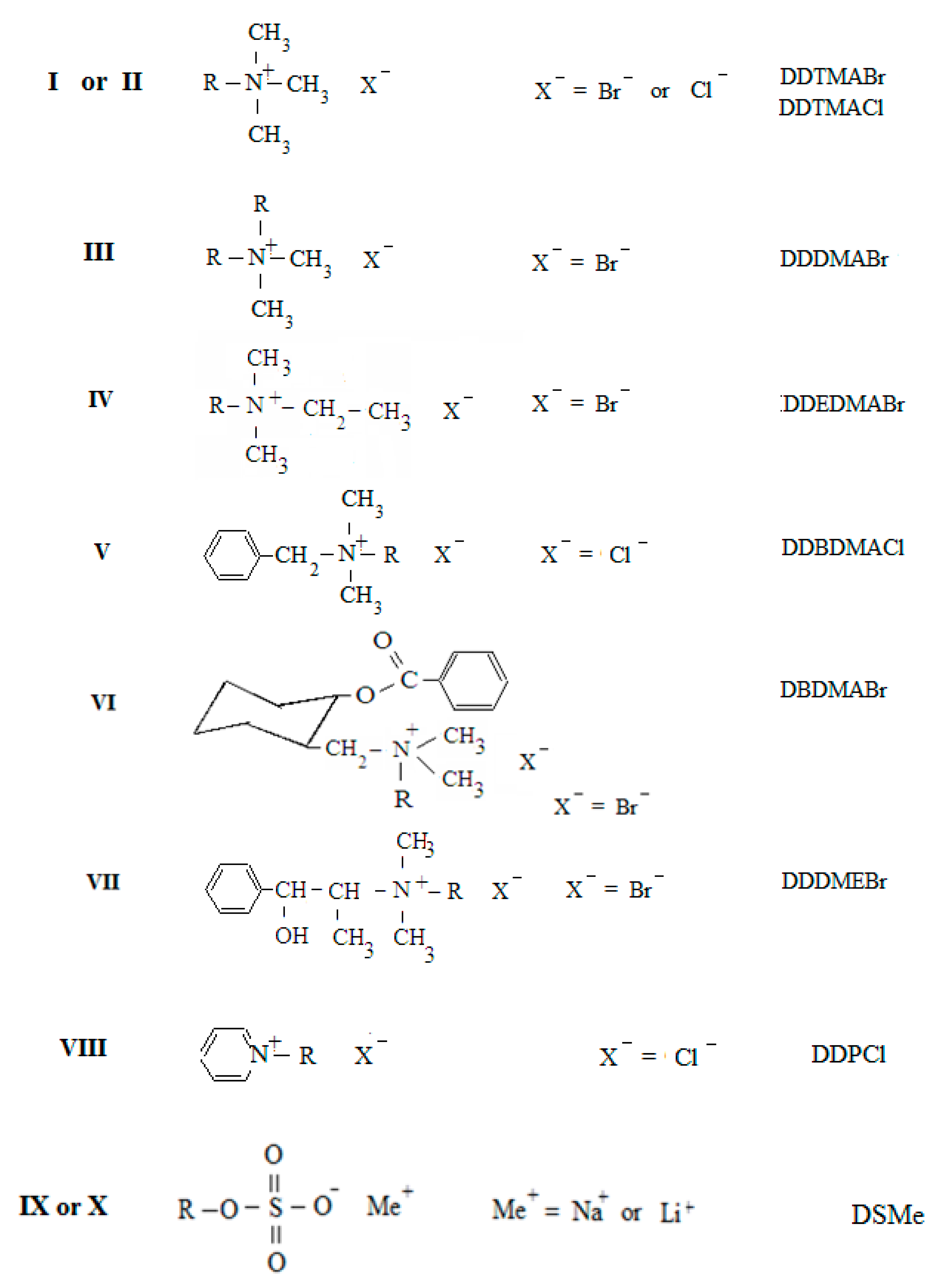

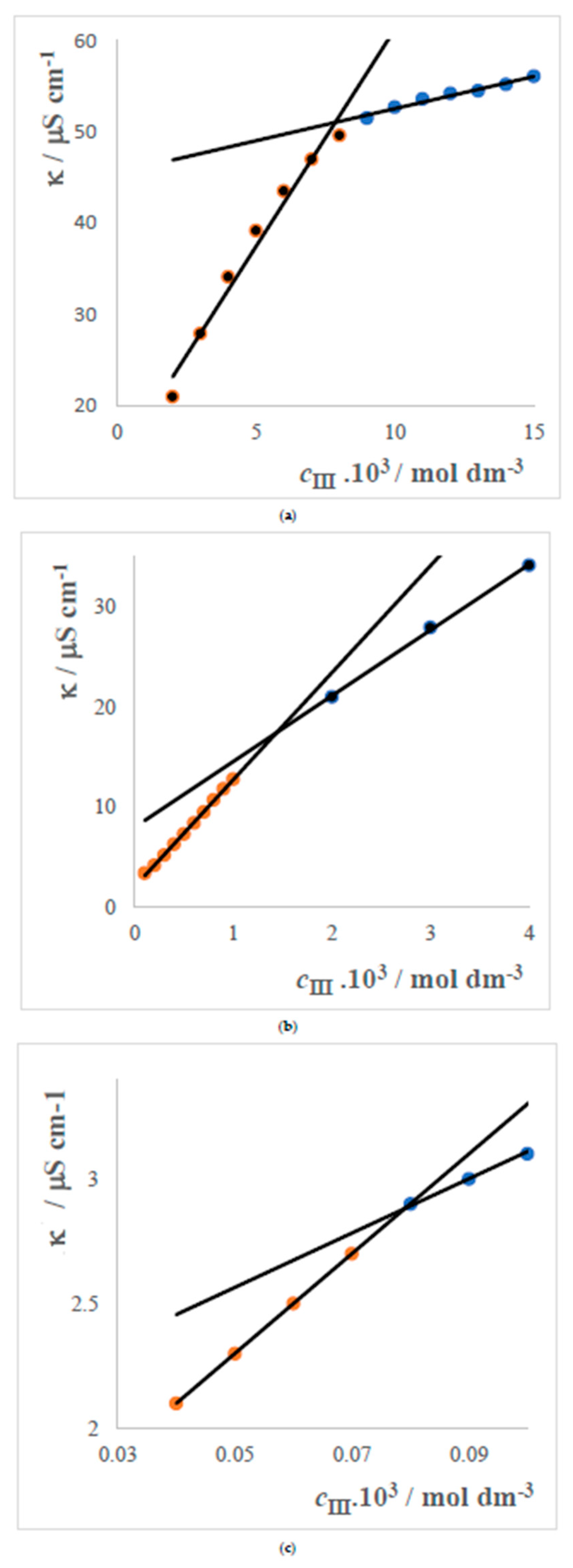

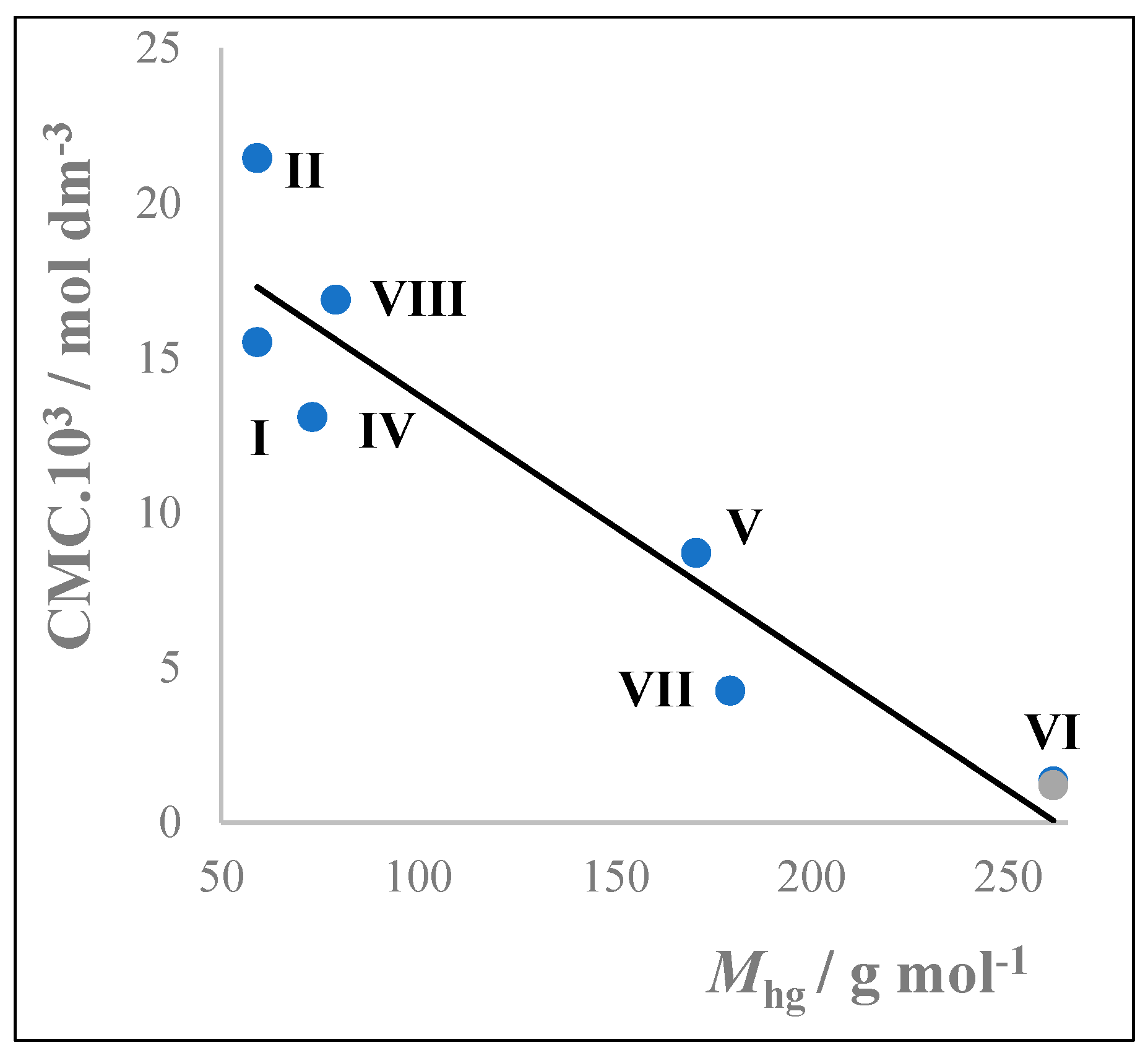
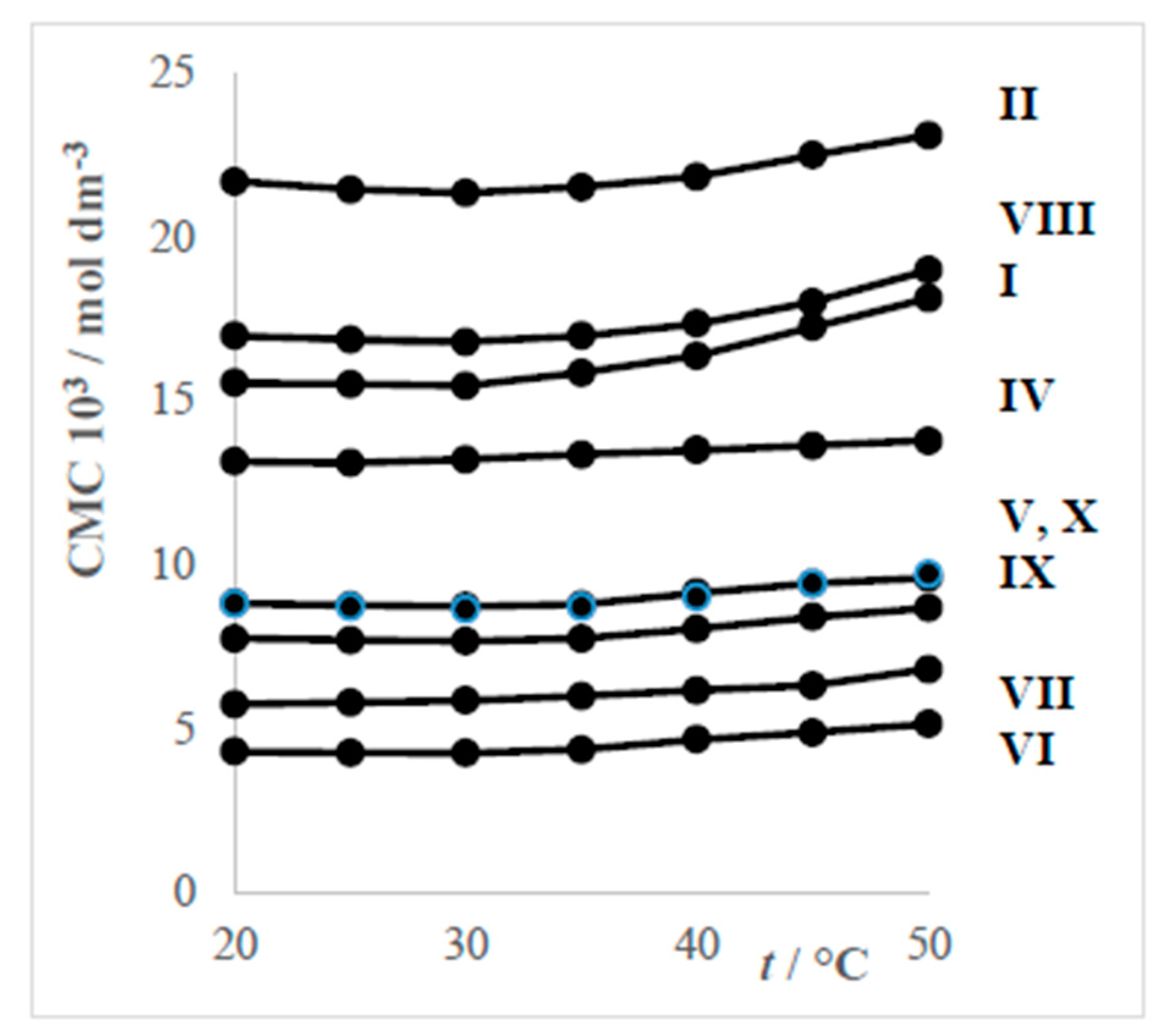

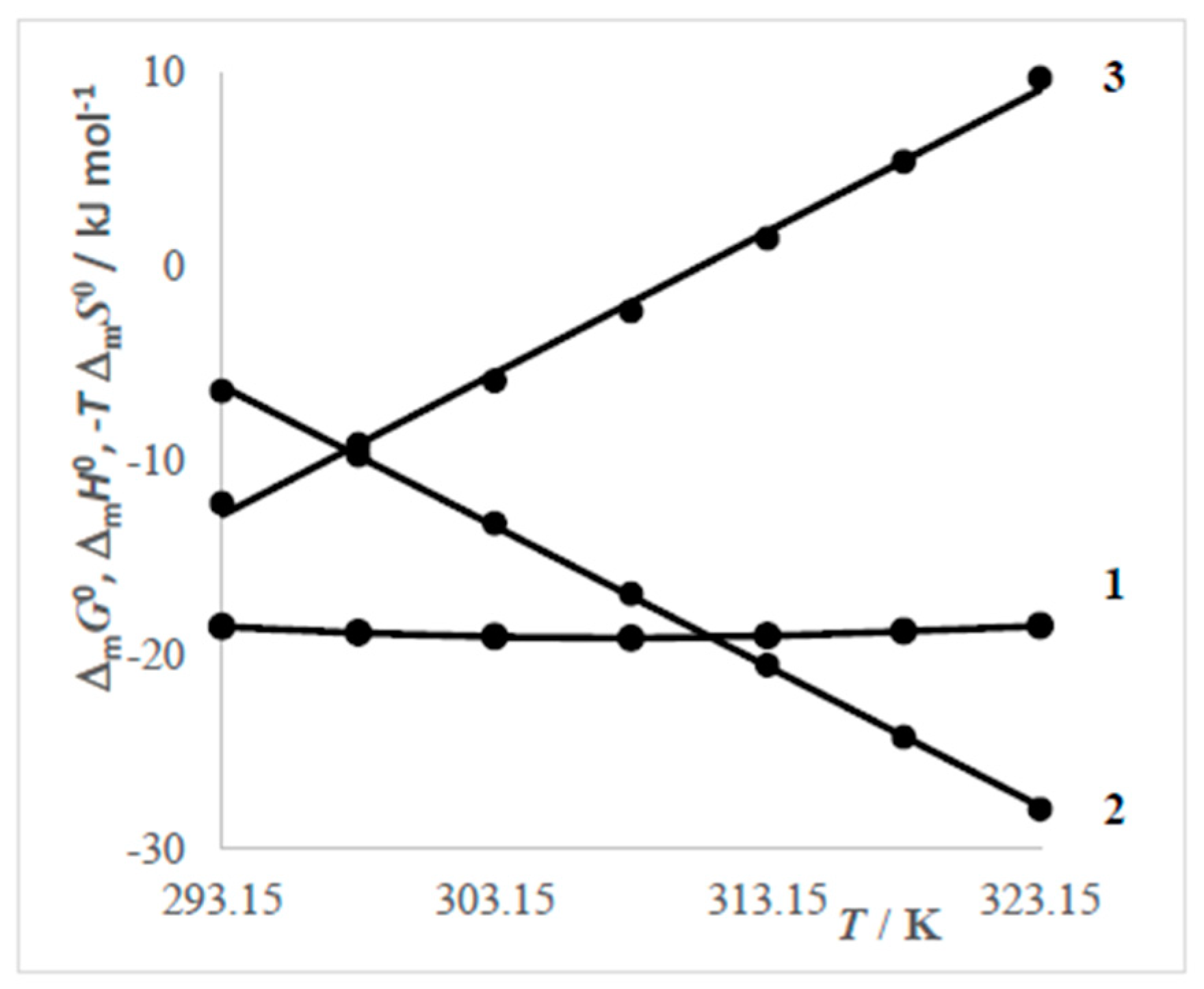
| Surfactant | Name of Substance | Supplier | Mc (g mol−1) | Mhg (g mol−1) | m.p. (°C) |
|---|---|---|---|---|---|
| DDTMABr I | Dodecyltrimethylammonium bromide | Aldrich | 308.35 | 59.12 | 246 |
| DDTMACl II | Dodecyltrimethylammonium chloride | Fluka Chemika | 263.90 | 59.12 | 246 |
| DDDMABr III | Didodecyldimethylammonium bromide | Fluka Chemika | 462.65 | 44.09 | 157–162 |
| DDEDMABr IV | Dodecylethyldimethylammonium bromide | Fluka Chemika | 350.43 | 73.14 | 149–151 |
| DDBDMACl V | Dodecylbenzyldimethylammonium chloride | Fluka Chemika | 384.45 | 170.66 | 60 |
| DBDMABr cis, trans VI | Dodecyl-[(2-benzyloxy)-cyclohexylmethyl]-N,N-dimethylammonium bromide | * | 497.58 | 261.37 | 127–129 |
| DDDMEBr VII | Dodecylmethylephedrinium bromide | Fluka Chemika | 428.50 | 179.26 | 104–106 |
| DDPCl VIII | Dodecylpyridinium chloride | Fluka Chemika | 284.00 | 79.10 | 66–70 |
| DSNa IX | Sodium dodecyl sulphate | Merck | 288.38 | 96.06 | 206 |
| DSLi X | Lithium dodecyl sulphate | Merck | 272.32 | 96.06 | 859 |
| (CMC ± sCMC ) 103 [ mol dm−3] | |||||||
|---|---|---|---|---|---|---|---|
| Surfactant | |||||||
| t [°C] | 20 | 25 | 30 | 35 | 40 | 45 | 50 |
| I | 15.54 ± 0.02 | 15.50 ± 0.02 | 15.45 ± 0.02 | 15.85 ± 0.01 | 16.38 ± 0.04 | 17.25 ± 0.02 | 18.12 ± 0.03 |
| II | 21.70 ± 0.03 | 21.44 ± 0.04 | 21.34 ± 0.02 | 21.52 ± 0.04 | 21.85 ± 0.03 | 22.50 ± 0.04 | 23.10 ± 0.05 |
| III CVC1 * CVC2 CVC3 | 7.29 ± 0.02 | 7.26 ± 0.03 1.66 ± 0.05 0.078 ± 0.04 | 7.21 ± 0.04 | 7.29 ± 0.02 | 7.52 ± 0.04 | 8.30 ± 0.03 | 9.17 ± 0.03 |
| IV | 13.14 ± 0.04 | 13.09 ± 0.03 | 13.21 ± 0.03 | 13.35 ± 0.03 | 13.49 ± 0.04 | 13.62 ± 0.05 | 13.78 ± 0.03 |
| V | 8.80 ± 0.03 | 8.70 ± 0.02 | 8.62 ± 0.02 | 8.69 ± 0.03 | 9.00 ± 0.05 | 9.42 ± 0.02 | 9.72 ± 0.04 |
| VI cis | 1.27 ± 0.03 | 1.32 ± 0.03 | 1.39 ± 0.02 | 1.54 ± 0.03 | 1.81 ± 0.03 | 2.04 ± 0.04 | 2.54 ± 0.03 |
| trans | 1.17 ± 0.02 | 1.20 ± 0.03 | 1.26 ± 0.03 | 1.42 ± 0.03 | 1.70 ± 0.03 | 1.93 ± 0.03 | 2.41 ± 0.04 |
| VII | 4.28 ± 0.03 | 4.25 ± 0.03 | 4.23 ± 0.04 | 4.35 ± 0.03 | 4.65 ± 0.03 | 4.86 ± 0.04 | 5.12 ± 0.05 |
| VIII | 16.98 ± 0.02 | 16.87 ± 0.02 | 16.80 ± 0.05 | 16.98 ± 0.04 | 17.35 ± 0,05 | 18.00 ± 0.03 | 18.98 ± 0.04 |
| IX | 7.73 ± 0.03 | 7.68 ± 0.02 | 7.65 ± 0.03 | 7.74 ± 0.03 | 8.02 ± 0.04 | 8.39 ± 0.05 | 8.66 ± 0.04 |
| X | 8.81 ± 0.03 | 8.74 ± 0.03 | 8.71 ± 0.02 | 8.78 ± 0.03 | 9.13 ± 0.04 | 9.41 ± 0.03 | 9.58 ± 0.03 |
| Alkyl | lC [Å] | V0 [Å3] | NAgg | r [Å] | a0 [Å2] | p |
|---|---|---|---|---|---|---|
| Dodecyl | 16.68 | 350.2 | 55.50 | 16.60 | 63.30 | 0.33 |
| Didodecyl | 16.68 | 703.5 | 27.63 | 34.07 | 61.94 | 0.68 |
| CMC 103 [mol dm−3] | |||||||||
|---|---|---|---|---|---|---|---|---|---|
| Surfactant | |||||||||
| t [°C] | 20 | 25 | 30 | 35 | 40 | 45 | 50 | Met. | Lit. |
| I | 15.54 | 15.50 | 15.45 | 15.85 | 16.38 | 17.25 | 18.12 | κ | present res. |
| 15.00 | κ | [18] | |||||||
| 11.40 | γ | ||||||||
| 15.20 | 15.50 | 15.90 | 16.20 | 16.50 | γ | [19] | |||
| 15.00 | 15.30 | 15.70 | 15.90 | 16.20 | γ | [20] | |||
| 10.07 | κ | [21] | |||||||
| 13.49 | κ | [22] | |||||||
| 14.50 | κ | [23] | |||||||
| 14.60 | γ | ||||||||
| 15.80 | 16.40 | 17.00 | κ | [24] | |||||
| 15.90 | f | ||||||||
| 15.70 | κ | [25] | |||||||
| 10.70 | NMR | [26] | |||||||
| 15.00 | ss | [27] | |||||||
| 15.60 | κ | [10] | |||||||
| II | 21.70 | 21.44 | 21.34 | 21.52 | 21.85 | 22.50 | 23.10 | κ | present res. |
| 21.20 | κ | [28] | |||||||
| 21.40 | γ | ||||||||
| 22.98 | 22.6 | 21.51 | 21.80 | 23.33 | 23.81 | H | [29] | ||
| 20.12 | 19.35 | 18.53 | 16.65 | 19.76 | 19.78 | κ | |||
| 22.60 | 22.20 | 21.70 | 21.90 | 22.20 | 22.70 | κ | [30] | ||
| 21.00 | κ | [31] | |||||||
| 21.00 | κ | [32] | |||||||
| 22.10 | 21.30 | 20.40 | 19.60 | κ | [33] | ||||
| III CVC1 CVC2 CVC3 CVC3 CVC2 CVC3 CVC3 | 7.29 | 7.26 1.66 0.079 0.050 0.70 0.048 0.050 | 7.21 | 7.29 | 7.52 | 8.30 | 9.17 | κ turb. | [63] [64] [65] |
| IV | 13.14 | 13.09 | 13.21 | 13.35 | 13.49 | 13.62 | 13.78 | κ | |
| 14.00 | κ | ||||||||
| 14.40 | κ | [34] | |||||||
| 9.50 | 10.50 | 11.00 | 13.50 | 14.00 | 17.00 | ρ | [35] | ||
| 9.30 | 10.00 | 10.80 | 11.30 | 12.00 | 15.30 | η | |||
| 13.00 | 14.00 | 15.00 | 15.55 | 15.80 | 16.50 | uv | |||
| 13.00 | 14.30 | 15.00 | 15.50 | 16.00 | 17.00 | κ | |||
| V | 8.80 | 8.62 | 8.69 | 9.00 | 9.42 | 9.72 | present res. | ||
| 8.80 | 8.83 | 8.99 | [36] | ||||||
| 8.70 | [37] | ||||||||
| VII | 4.28 | 4.25 | 4.23 | 4.35 | 4.65 | 4.86 | 5.12 | κ | present res. |
| 3.94 | 4.04 | 4.16 | 4.34 | 4.54 | 5.00 | κ | [38] | ||
| 4.05 | 4.50 | 4.99 | EMV | ||||||
| 4.10 | 4.60 | 5.02 | UV | ||||||
| 4.12 | 4.40 | 5.00 | γKrus | ||||||
| 4.08 | 4.53 | 5.00 | γdrop | ||||||
| VIII | 16.98 | 16.87 | 16.80 | 16.98 | 17.35 | 18.00 | 18.94 | κ | present res. |
| 16.80 | 18.00 | 19.10 | 20.00 | κ | [39] | ||||
| 16.50 | κ | [37] | |||||||
| 16.20 | κ | [40] | |||||||
| 17.13 | γ | [41] | |||||||
| 17.68 | κ | ||||||||
| 19.20 | 17.20 | 13.70 | 19.80 | 21.70 | κ | [42] | |||
| 18.90 | 18.00 | 18.50 | 20.00 | 21.00 | κ | [43] | |||
| 16.70 | 15.60 | 17.50 | 18.20 | 19.60 | γ | ||||
| 16.20 | 17.29 | 17.80 | 18.41 | 19.42 | κ | [44] | |||
| 15.00 | κ | 50 | |||||||
| 16.00 | κ | 51 | |||||||
| IX | 7.73 | 7.68 | 7.65 | 7.74 | 8.02 | 8.39 | 8.66 | κ | present res. |
| 8.30 | κ | [37] | |||||||
| 9.16 | 7.96 | 4.49 | 3.70 | γ | [47] | ||||
| 7.98 | κ | [48] | |||||||
| 7.96 | κ | [49] | |||||||
| 7.80 | 8.60 | 9.80 | 10.60 | κ | [50] | ||||
| 8.70 | 8.20 | 8.65 | 8.90 | 9.00 | 9.10 | κ | [51] | ||
| 8.10 | f | ||||||||
| 8.11 | UV | ||||||||
| 8.50 | UV | [52] | |||||||
| 8.26 | κ | [53] | |||||||
| 8.26 | f | ||||||||
| 8.25 | γ | [54] | |||||||
| 8.85 | κ | ||||||||
| 8.85 | f | ||||||||
| 8.70 | 8.20 | 8.65 | 8.90 | 9.00 | 9.10 | κ | [55] | ||
| 8.30 | 7.70 | 8.10 | H | [56] | |||||
| 8.10 | 8.70 | 9.20 | γ | ||||||
| X | 8.81 | 8.74 | 8.71 | 8.78 | 9.13 | 9.41 | 9.58 | κ | present res. |
| 8.98 | κ | ||||||||
| 7.12 | γ | [57] | |||||||
| 9.09 | 8.98 | 9.06 | 9.21 | 9.32 | 9.39 | κ | [58] | ||
| 8.96 | 9.28 | ρ | |||||||
| 8.93 | 9.18 | c | |||||||
| 8.77 | κ | [59] | |||||||
| 8.90 | κ | [60] | |||||||
| β | |||||||
|---|---|---|---|---|---|---|---|
| Surfactant | |||||||
| t [°C] | 20 | 25 | 30 | 35 | 40 | 45 | 50 |
| I | 0.536 | 0.522 | 0.518 | 0.496 | 0.477 | 0458 | 0.444 |
| II | 0.497 | 0.490 | 0.482 | 0.473 | 0.458 | 0.433 | 0.409 |
| III | 0.752 | 0.748 | 0.742 | 0.730 | 0.709 | 0.689 | 0.650 |
| IV | 0.604 | 0.597 | 0.587 | 0.584 | 0.563 | 0.542 | 0.521 |
| V | 0.609 | 0.605 | 0.593 | 0.574 | 0.553 | 0.524 | 0.488 |
| VI cis | 0.460 | 0.453 | 0.442 | 0.423 | 0.407 | 0.385 | 0.361 |
| trans | 0.464 | 0.460 | 0.449 | 0.432 | 0.412 | 0.393 | 0.371 |
| VII | 0.633 | 0.628 | 0.620 | 0.609 | 0.576 | 0.534 | 0.512 |
| VIII | 0.519 | 0.510 | 0.492 | 0.478 | 0.459 | 0.436 | 0.411 |
| IX | 0.465 | 0.459 | 0.440 | 0.420 | 0.397 | 0.371 | 0.352 |
| X | 0.507 | 0.501 | 0.492 | 0.478 | 0.465 | 0.441 | 0.419 |
| ΔmG0 [kJ mol−1] | |||||||
|---|---|---|---|---|---|---|---|
| Surfactant | |||||||
| T [K] | 293.15 | 298.15 | 303.15 | 308.15 | 313.15 | 318.15 | 323.15 |
| I | −15.59 | −15.70 | −15.95 | −15.92 | −15.81 | −15.66 | −15.56 |
| II | −13.97 | −14.19 | −14.37 | −14.49 | −14.51 | −14.38 | −14.26 |
| III | −22.12 | −22.47 | −22.80 | −22.90 | −22.76 | −22.30 | −21.57 |
| IV | −16.93 | −17.16 | −17.31 | −17.52 | −17.52 | −17.52 | −17.51 |
| V | −18.56 | −18.88 | −19.09 | −19.14 | −19.05 | −18.80 | −18.22 |
| VI cis | −23.73 | −23.88 | −23.91 | −23.61 | −23.13 | −22.69 | −21.85 |
| trans | −24.09 | −24.34 | −24.38 | −24.06 | −23.44 | −23.03 | −22.20 |
| VII | −21.71 | −22.04 | −22.32 | −22.41 | −22.04 | −21.61 | −21.43 |
| VIII | −15.09 | −15.28 | −15.37 | −15.43 | −15.40 | −15.26 | −15.03 |
| IX | −17.36 | −17.61 | −17.69 | −17.68 | −17.55 | −17.34 | −17.25 |
| X | −17.38 | −17.63 | −17.84 | −17.93 | −17.91 | −17.78 | −17.77 |
| Equation | (15) | (16) | ||||
|---|---|---|---|---|---|---|
| Parameter | B | C | R * | b | Sb ** | r |
| I | −0.15573 | 0.00026 | 0.998 | −0.00318 | 0.00019 | 0.990 |
| II | −0.10799 | 0.00018 | 0.997 | −0.00287 | 0.00034 | 0.970 |
| III | −0.38990 | 0.00065 | 0.996 | −0.00326 | 0.00049 | 0.946 |
| IV | −0.02161 | 0.00004 | 0.991 | −0,00273 | 0,00032 | 0.970 |
| V | −0.15551 | 0.00026 | 0.989 | −0.00293 | 0.00029 | 0.977 |
| VI cis | −0.37643 | 0,00065 | 0.998 | −0.00384 | 0.00025 | 0.986 |
| trans | −0.41442 | 0.00071 | 0.998 | −0.00375 | 0.00021 | 0.992 |
| VII | −0.17483 | 0.00029 | 0.989 | −0.00250 | 0.00060 | 0.990 |
| VIII | −0.15025 | 0.00025 | 0.998 | −0.00361 | 0.00022 | 0.992 |
| IX | −0.13788 | 0.00023 | 0.992 | −0.00399 | 0.00023 | 0.991 |
| X | −0.10241 | 0.00017 | 0.977 | −0.00293 | 0.00021 | 0.987 |
| ΔmH0 [kJ mol−1] | |||||||
|---|---|---|---|---|---|---|---|
| Surfactant | |||||||
| T [K] | 293.15 | 298.15 | 303.15 | 308.15 | 313.15 | 318.15 | 323.15 |
| I | −5.85 | −9.14 | −12.34 | −15.73 | −19.22 | −22.78 | −26.50 |
| II | −5.23 | −7.43 | −9.73 | −12.12 | −14.55 | −17.06 | −19.59 |
| III | −1.04 | −9.51 | −18.52 | −27.90 | −37.56 | −47.37 | −57.03 |
| IV | −10.56 | -11.39 | −12.23 | −13.11 | −13.97 | −14.85 | −15.76 |
| V | −6.38 | −9.71 | −13.23 | −16.85 | −20.53 | −24.23 | −27.97 |
| VI cis | −23.16 | −30.80 | −38.76 | −46.78 | −54.94 | −63.33 | −75.52 |
| trans | −20.02 | −28.30 | −36.90 | -45.59 | −54.32 | −62.51 | −72.54 |
| VII | −4.14 | −7.80 | −11.67 | −15.68 | −19.68 | −23.72 | −27.98 |
| VIII | −6.52 | −9.58 | −12.78 | −16.08 | −19.45 | −22.87 | −26.30 |
| IX | −10.69 | −13.57 | −16.58 | −19.65 | −22.72 | −25.82 | −29.09 |
| X | −6.95 | −9.11 | −11.37 | −13.71 | −16.07 | −18.49 | −21.01 |
© 2019 by the authors. Licensee MDPI, Basel, Switzerland. This article is an open access article distributed under the terms and conditions of the Creative Commons Attribution (CC BY) license (http://creativecommons.org/licenses/by/4.0/).
Share and Cite
Oremusová, J.; Vitková, Z.; Vitko, A.; Tárník, M.; Miklovičová, E.; Ivánková, O.; Murgaš, J.; Krchňák, D. Effect of Molecular Composition of Head Group and Temperature on Micellar Properties of Ionic Surfactants with C12 Alkyl Chain. Molecules 2019, 24, 651. https://doi.org/10.3390/molecules24030651
Oremusová J, Vitková Z, Vitko A, Tárník M, Miklovičová E, Ivánková O, Murgaš J, Krchňák D. Effect of Molecular Composition of Head Group and Temperature on Micellar Properties of Ionic Surfactants with C12 Alkyl Chain. Molecules. 2019; 24(3):651. https://doi.org/10.3390/molecules24030651
Chicago/Turabian StyleOremusová, Jarmila, Zuzana Vitková, Anton Vitko, Marián Tárník, Eva Miklovičová, Oľga Ivánková, Ján Murgaš, and Daniel Krchňák. 2019. "Effect of Molecular Composition of Head Group and Temperature on Micellar Properties of Ionic Surfactants with C12 Alkyl Chain" Molecules 24, no. 3: 651. https://doi.org/10.3390/molecules24030651
APA StyleOremusová, J., Vitková, Z., Vitko, A., Tárník, M., Miklovičová, E., Ivánková, O., Murgaš, J., & Krchňák, D. (2019). Effect of Molecular Composition of Head Group and Temperature on Micellar Properties of Ionic Surfactants with C12 Alkyl Chain. Molecules, 24(3), 651. https://doi.org/10.3390/molecules24030651





